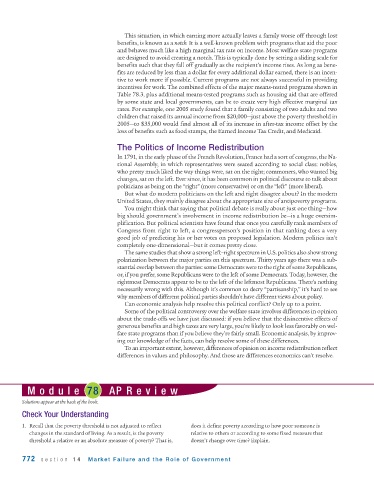Page 814 - Krugmans Economics for AP Text Book_Neat
P. 814
This situation, in which earning more actually leaves a family worse off through lost
benefits, is known as a notch. It is a well-known problem with programs that aid the poor
and behaves much like a high marginal tax rate on income. Most welfare state programs
are designed to avoid creating a notch. This is typically done by setting a sliding scale for
benefits such that they fall off gradually as the recipient’s income rises. As long as bene-
fits are reduced by less than a dollar for every additional dollar earned, there is an incen-
tive to work more if possible. Current programs are not always successful in providing
incentives for work. The combined effects of the major means-tested programs shown in
Table 78.3, plus additional means-tested programs such as housing aid that are offered
by some state and local governments, can be to create very high effective marginal tax
rates. For example, one 2005 study found that a family consisting of two adults and two
children that raised its annual income from $20,000—just above the poverty threshold in
2005—to $35,000 would find almost all of its increase in after-tax income offset by the
loss of benefits such as food stamps, the Earned Income Tax Credit, and Medicaid.
The Politics of Income Redistribution
In 1791, in the early phase of the French Revolution, France had a sort of congress, the Na-
tional Assembly, in which representatives were seated according to social class: nobles,
who pretty much liked the way things were, sat on the right; commoners, who wanted big
changes, sat on the left. Ever since, it has been common in political discourse to talk about
politicians as being on the “right” (more conservative) or on the “left” (more liberal).
But what do modern politicians on the left and right disagree about? In the modern
United States, they mainly disagree about the appropriate size of antipoverty programs.
You might think that saying that political debate is really about just one thing—how
big should government’s involvement in income redistribution be—is a huge oversim-
plification. But political scientists have found that once you carefully rank members of
Congress from right to left, a congressperson’s position in that ranking does a very
good job of predicting his or her votes on proposed legislation. Modern politics isn’t
completely one-dimensional—but it comes pretty close.
The same studies that show a strong left–right spectrum in U.S. politics also show strong
polarization between the major parties on this spectrum. Thirty years ago there was a sub-
stantial overlap between the parties: some Democrats were to the right of some Republicans,
or, if you prefer, some Republicans were to the left of some Democrats. Today, however, the
rightmost Democrats appear to be to the left of the leftmost Republicans. There’s nothing
necessarily wrong with this. Although it’s common to decry “partisanship,” it’s hard to see
why members of different political parties shouldn’t have different views about policy.
Can economic analysis help resolve this political conflict? Only up to a point.
Some of the political controversy over the welfare state involves differences in opinion
about the trade-offs we have just discussed: if you believe that the disincentive effects of
generous benefits and high taxes are very large, you’re likely to look less favorably on wel-
fare state programs than if you believe they’re fairly small. Economic analysis, by improv-
ing our knowledge of the facts, can help resolve some of these differences.
To an important extent, however, differences of opinion on income redistribution reflect
differences in values and philosophy. And those are differences economics can’t resolve.
Module 78 AP Review
Solutions appear at the back of the book.
Check Your Understanding
1. Recall that the poverty threshold is not adjusted to reflect does it define poverty according to how poor someone is
changes in the standard of living. As a result, is the poverty relative to others or according to some fixed measure that
threshold a relative or an absolute measure of poverty? That is, doesn’t change over time? Explain.
772 section 14 Market Failure and the Role of Gover nment

